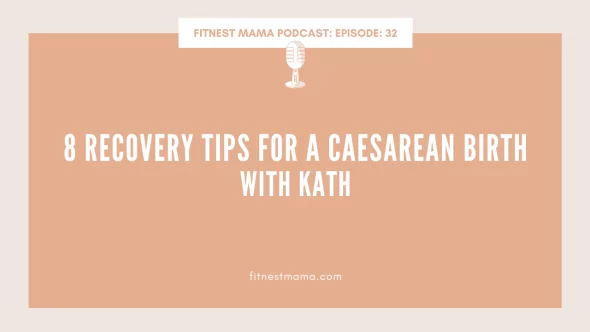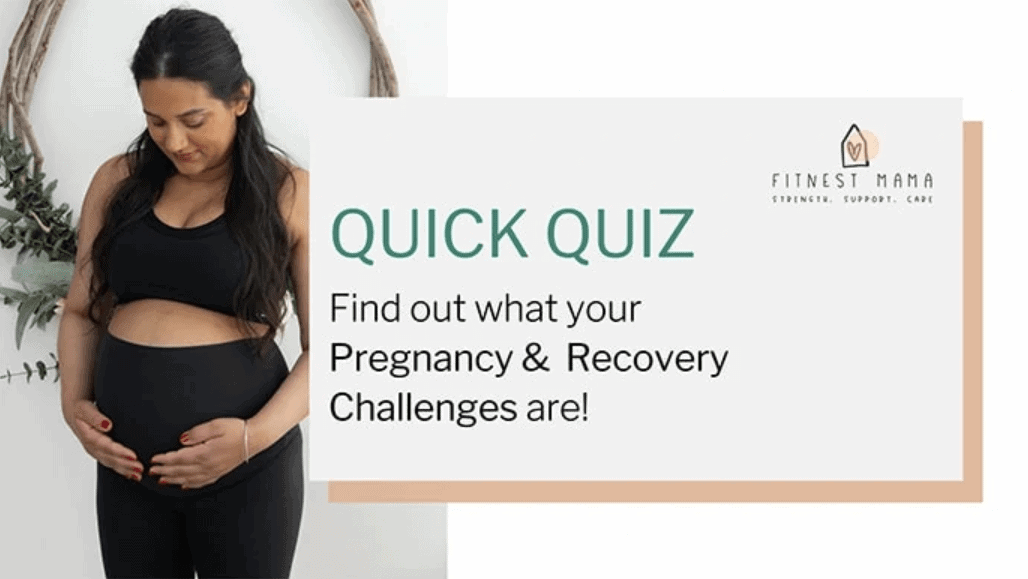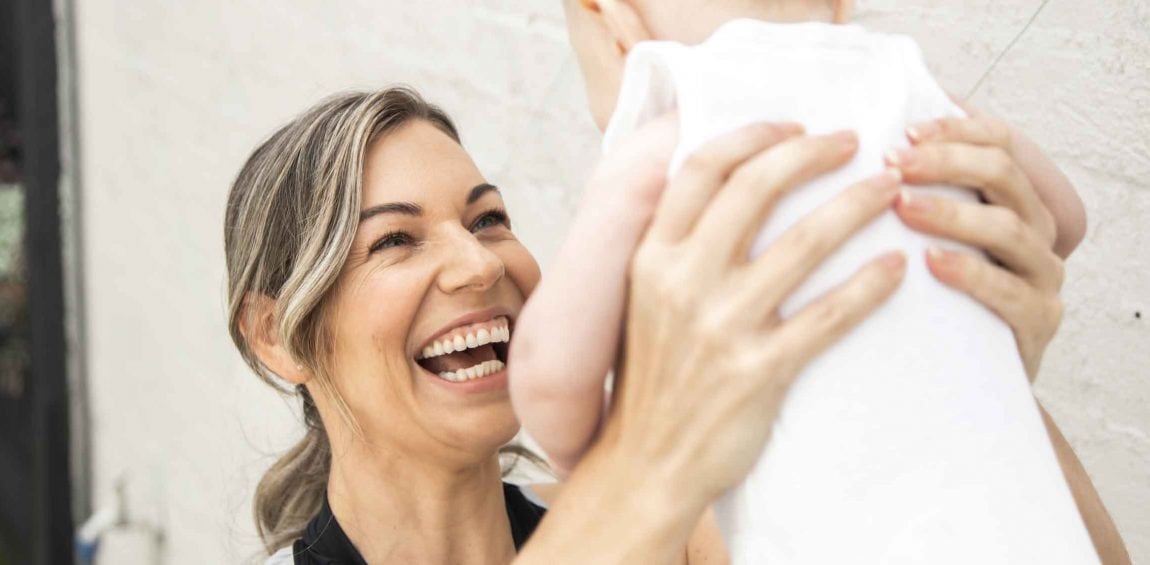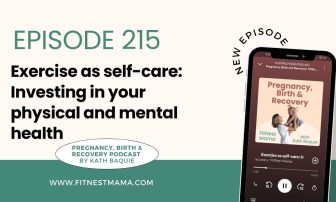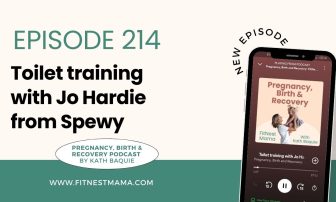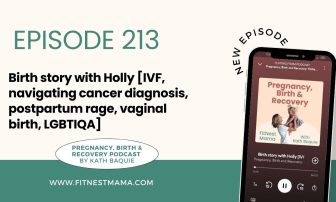Well, hi there! Welcome to Episode 32 of the FitNest Mama Podcast which is all about Recovery After a Caesarean Birth. So stick around because whether or not you have a plan caesarean or an emergency caesarean, this episode is for you. I’m your host Kath Baquie, I’m a mum of 3 young girls, a physio for women. And I have an online community, FitNest Mama, which helps to provide pregnant and new mothers with the exercises, support and resources that they need to move from the overwhelming physical aches and pains of pregnancy, the weakness felt after birth. And instead we replaced that with the comfort and confidence they need to get their bodies and minds strong again so that they can get back to doing what they love with a bubba by their side. Whether or not that’s running around with the kids at the park or running the next marathon.
So April is Caesarean Awareness Month. Earlier this month I chatted with the lovely Vanessa Bernard from Illoura Birth all about hypnobirthing versus caesarean birth. So scroll back a few episodes for that one. And today, I’m going to take it one step further, and I want to discuss a few ways to help with the afterbirth recovery after a caesarean. It is a question I commonly get asked by new mums. You know, “I’ve had a caesarean. How can I help my body recover? So I have eight quick tips for you coming right up.
But first I want to let you know about a free Pregnancy and Postnatal Quiz that I have developed. Head to https://fitnestmama.com/quiz to complete this really quick and easy pregnancy or postnatal quiz where you can determine what your main challenges are during pregnancy and postpartum. And you also get some really great tips and tricks after doing the quiz. So keep an eye out for that. So it’s https://fitnestmama.com/quiz. And the link is also in the show notes.
Alright, let’s get into the show. So I’ve got eight quick tips. I’m going to try to keep this episode nice and short and sweet. The first tip for recovery after caesarean. So I’m really talking about the physical side of things here. I know there’s a lot of other elements that go alongside with recovery after a caesarean. But here I really do want to focus on your body and how your body’s feeling.
Okay, so the first tip I need to mention is trying to avoid or manage any constipation. Constipation can be really common after birth, including after a caesarean. There’s hormonal changes. There’s different food in the hospital. There’s a new environment you’re in. There’s so many different reasons why constipation after birth is super common and that’s what we call the first proof. It can often be quite daunting for new mums. So talk to your healthcare team. Whether or not you want to be proactive about having stool softness. Have a chat to your doctor and your midwives, whether or not that’s appropriate for you.
And the other tip around this is really trying not to strain. So if you’re having some difficulty, when you do get the urge to go to the toilet, try to get yourself into a good position. So that’s generally relaxing with the elbows on your knees for leaning forwards, taking a few nice deep breaths and letting your tummy relax. So often, if your tummy is relaxed, then your pelvic floor is also relaxed. And if you’re taking some nice deep breaths that can really help to lead at all, I guess and that they’re not straining is really important to help protect that whole area and also to reduce the amount of strain going through your caesarean wound as well.
Okay, so the second tip that is really great in those early few days after you’ve had a caesarean is to do a log roll. So it can be quite uncomfortable to move around in those early days after a caesarean and I find with the mums that I’ve seen in hospital. This is n really lovely way to get out of bed that puts as little strain through that abdominal area as possible. First of all, we need to get ourselves closer to the edge of the bed. So you might need to bring your knees up to a bridge. So lift up your bottom and bring yourself to the edge of the bed, then you do a log roll. So you’re rolling like a log with a nice straight back onto your side. And then once you’re on the edge of the bed, and you’re lying on your side, then if you let your feet go over the edge, and you use your hands to push you up, that can be a really lovely way to get up into seating with as little effort as possible. And I actually recommend all women do this postnatally. Whether or not you have a caesarean or vaginal birth, because it really does help to let your abdominals rest as much as possible. So whether or not you’ve got a wound, a caesarean wound there, or you’ve got abdominal muscle separation, a log roll is a lovely way to get out of bed, and then getting back into bed the same way in reverse. So you start sitting on the edge of the bed, then you go on to your side, and then you’re back. Hopefully that makes sense. It’s a very visual thing. And it is pretty tricky to explain on a podcast.
Okay. The third tip, so we’ve talked about constipation, we’ve talked about log rolling. The third tip is to support your wound if you need to cough, or laugh, or sneeze or any of those sorts of things. So hopefully, you could grab a, that can be pillow close by. A nice support of pillow that you could press gently to your tummy area, if you feel like you need to cough or laugh or sneeze. So it’s called a supported cough. If you don’t have your pillow close by, you could even use your hands for some gentle support. If you’re not sure what I’m talking about here, asking midwives or your health care team, and they will easily be able to show you but knowing about this beforehand, I think is really helpful. Rather than suddenly doing a cough. And then it might be uncomfortable, or it might not feel good. So really good to be proactive and know about this before you’re in the situation.
Okay, fourth tip, which is I sometimes feel so silly saying this, because it’s so obvious. But I feel it’s hard to do, like I totally get it but it’s rest. And when I say rest, I don’t mean lying down all day. Because I know that’s impossible. If you’re a new mum, you might have a toddler at home as well. Resting can be really challenging. But even if for you, this means five minutes of lying down. When you can say five minutes at lunchtime or five minutes in the afternoon getting a bit of that horizontal rest throughout the day, for short bursts. Especially when you go home. It’s easy to rest in hospital where you’re in a small room isn’t not much to do, obviously, except for caring for your baby, which is a lot. But when you go home, suddenly, there’s a whole lot of extra demands that are often on the mum, on you, which hopefully we can get rid of. But if we can get as much rest as possible, even short little bursts of rest here and there. That’s amazing. I haven’t had a caesarean delivery. I’ve had three vaginal deliveries, but I’ve got some really close friends who’ve had caesarean deliveries. And they always said the best tip to anyone is just to make sure you don’t have to cook anything for six weeks. And you don’t have to do any cleaning for six weeks. Because for them that means they’re resting, they’re not having to be up on their feet while they’re cleaning or cooking for those six weeks. So whether or not that means frozen meals or you’re eating out or you’re calling upon some extra help, whatever that means for you. And that will look different for everyone. No housework, no cooking, six weeks, amazing. But at the very least five minutes of horizontal risks or lying down here and there when you can, is great.
Okay, we talked about constipation log rolling, a supported cough, rest. The fifth one that commonly gets asked about is what abdominal support should I use? So abdominal support. There’s so much on the market now. It’s sometimes a bit overwhelming. So I’m going to keep it simple, but just knowing that there’s lots of different supports and I don’t think there’s necessarily one amazing one out there that is better than the other. So I think it’s all very much personal preference. It depends on finances and lots of things. So in those early few days, when you’re in hospital, having you know the really common recovery shorts, they might be a bit tricky to put on. I generally recommend don’t try to put on recovery shorts until the day you go home or, you know, at least stay five, around day five I find is the most well tolerated day to put on the recovery shorts. Any earlier and it can be a bit of a struggle. So those first few days, I think abdominal Tubi Grip, or some sort of belly band is, again, there’s a lot on the market, so check what’s appropriate for you, but I love Tubi Grip. It’s often available in the hospital system. It depends which hospital you’re at, and I think it depends if it’s private or public, but it’s worth asking the midwife, “Is there any abdominal Tubi Grip that I can purchase or that I can get?” They might have a pharmacy downstairs that sells the Tubi Grip. And then this might also be something you look at getting when you’re still pregnant. So a lot of women’s health physio clinics do stock the postnatal Tubi Grip. Again, there’s a lot on the market. So I’m not pro on one particular brand. I just find that Tubi Grip is simple, and it’s quite cheap and cost effective. And it’s really comfortable and generally well tolerated and a lot of my mum’s so the first few days, you might need some Tubi Grip. Look, it’s not to say it’s going to help with recovery, but generally mums just like the feel of it. It helps them to feel more supported. It helps them to feel good. And then not putting on this SRC shorts or anything. That’s the strongest support until your few days later.
Okay, hopefully, that all makes sense. I know it’s a bit of a grey area. But I would love to hear from you. What sort of abdominal support did you love? In your afterbirth recovery? Send me a DM on Instagram @fitnestmama. So f-i-t-n-e-s-t-m-a-m-a. I would love to hear from you. What support do you have? Or what abdominal support have you used? And what did you love? There’s SRC Recovery Shorts is solidea. Too quite well known ones. And then there’s lots of smaller brands as well, which are also I’m sure equally as good.
Number six tip, moving right along, is no heavy lifting. And I think this is known about and I don’t need to talk too much about it. Because often, the medical staff tell everyone in hospital don’t lift anything heavier than your baby for six weeks. And that it is super important. And I know it can also be challenging if you have a toddler in the house. But no heavy lifting or lifting. Nothing that’s heavier than your baby is something again that I recommend for all women, whether or not you have a vaginal delivery or a caesarean delivery, it helps with so many different elements that helps with your caesarean wound recovery, it can help with pelvic floor recovery. It’s a good one. But again, it can be hard to do if you’ve got a toddler in the house. And this might be something you need to brainstorm when you’re still pregnant too. I know if you’ve been listening to this podcast a lot, you’ve probably heard me say it over and over again. But I loved the white steps, those lightweight steps that you can move around the house. You can get them from Kmart. They don’t have to cost a lot but to be able to move them from the basin. So your toddler can wash their hands a bit more independently, or to the bath so they can get themselves in and out of the bath a little bit more independently or on and off the change table. Having some little steps to move around the house from room to room can be really helpful in getting your toddler just to help with that little bit extra so that you’re not having to lift them up quite so often.
The next one is build up walking gradually. Okay, this is another really common question is how much can I walk in those early days again, it’s very individual. And if you want a tailored advice to you definitely go and have a chat to your healthcare provider. And if there’s been any medical issues as well, do please have a chat to your medical provider. But on the whole, I tend to recommend building up five minutes each week. So I know that doesn’t sound like a lot. But I figure you’ve got the rest of your life to get fit and strong again after having a baby those first six weeks, and I’d argue, even longer. The most important thing isn’t how far you’re walking. It’s about rest and recovery. So important. So let’s break this down. If in the first week you’re just walking around the house, you know, zero to five minutes walking here walking there. The next week, you’d be walking 10 minutes, the following week, 15 minutes, 20 minutes, 25. So by the time you get to six weeks postnatal you’re walking 30 minutes, and I think that’s great. I’ve heard a lot of women tell stories about how when they’re weak to postnatal they’re feeling great and they might have gone out for 30-minute walk. And then by the time they get home, they don’t feel so great. So I really do think less is more and again, being proactive, rather than reactive and doing too much, and then thinking, “Oh, what a shame I’ve done too much.” So, for pain levels, for your fatigue and for your energy levels and your recovery, “Less is best”, is my philosophy in those first six weeks.
Okay. Postnatal rehab from the six weeks onwards, or once you’ve had your medical check, or whenever you coming out of that newborn haze, this is where, again, again, you know, talking about postnatal rehab, I feel that women on the whole, we need to really, it is so important that each and every one of us tries to help our body recover after childbirth, our body has been through such an amazing thing. You know, having this baby brought into the world, had major abdominal surgery, and there’s nothing better than really helping, over the following 12 months and beyond, helping your body gradually restore and recover. So this is one huge reason I developed FitNest Mama, because I feel that postnatal rehab, as a general society, we don’t do properly. And this is where I take my mums through step by step approach, to really help them regain their fitness and strength in a safe way that’s really focusing on their pelvic floor and core. So again, if you listen to this podcast, you’ll hear me tell this story about the football player, they might have ACL injury on the footy field, and they might need to have surgery. And what happens after they have that surgery, they have a period of rest and recovery. Then they have a period of rehab. They might start and do some basic things at the gym, some strength work. Then they might start some gentle running drills before they finally get back into training. And then they slowly get back into competitive football too. Whereas women on the whole as a society, I feel like we tend to go from having our rest, and then plodding along until maybe 6 to 10 months later, you’re finally feeling good.
You might be asked to go and play in that ball game with a friend or go for a run. Or you go back to the gym and do a hit class. And that’s when often I find women come and see me in the clinic. Because I’ve got aches and pains or pelvic floor issues or whatever it may be so postnatal rehab, amazing. So this will look different for everyone, you might want to see or go to that face to face that local clinic close to you. You might want the convenience of an online program that you can do when your baby’s lying next to you like FitNest Mama. So this will look different to everyone but whatever it is, if you could all, like everyone listening, have think what would work for me and my lifestyle. And then the one thing I haven’t talked about is c-scar massage. So this probably does need a podcast on its own. But it’s also very visual. So I teach the caesarean scar massage in the membership in FitNest Mama. So once the wound is fully healed, the doctors said they’re really happy with the healing. And generally from 6 to 12 weeks onwards, that’s when I gently encourage a progressive c-scar massage. It’s funny if we’d had a wound on any other part of the body, generally people are told to you know massage your scar and do your scar massage. But I feel like women are often, there’s so much other stuff going on after you have a baby and often we forget to do it after caesarean delivery. And I do see women down the track in the clinic with issues of sometimes they might develop issues of hypersensitivity where the scar is really sensitive to touch. And they might hate it when the feeling of clothes rubbing against this scar can be really uncomfortable or leaning on a change table can sometimes be really uncomfortable. And then on the flip side, sometimes there’s issues with numbness and it feels a bit number around the area. So this is where massage might be really helpful for you. And inside the membership I teach you how to do a light touch massage for the earlier days. And then deeper massage as time goes on. But again, this is something that’s really important you do make sure the patient is fully healed. So check with your medical team before you get started with scar massage. And if you need help, just come and join us inside FitNest Mama.
So that’s it ladies! So I think I mentioned nine tips. Actually we talked about constipation, log roll supported cough, resting, abdominal support, no heavy lifting, build up your walking gradually, postnatal rehab and caesarean scar massage. So hopefully that was helpful. Let me know. I’d love to hear from you send me a DM on Instagram – @fitnestmama. So before I sign off remember my team and I will be putting together the Show Notes for this episode with all the links at https://fitnestmama.com/podcast including how to do the Free Pregnancy Quiz. So that’s it. Thank you ladies. Hope you have a lovely day everyone and I look forward to seeing you next week for another episode of the FitNest Mama Podcast.
Thanks for listening to the FitNest Mama Podcast brought to you by the FitNest Mama Freebies found at www.fitnestmama.com/free. So please take a few seconds to leave a review, subscribe, so you don’t miss an episode. And be sure to take a screenshot of this podcast uploaded to your social media and tag me – @fitnestmama, so I can give you a shout out too. Until next time. Remember, an active pregnancy, confident childbirth, and strong postnatal recovery is something that you deserve. Remember our disclaimer, materials and contents in this podcast are intended as general information only and shouldn’t substitute any medical advice, diagnosis or treatment. I’ll see you soon.
